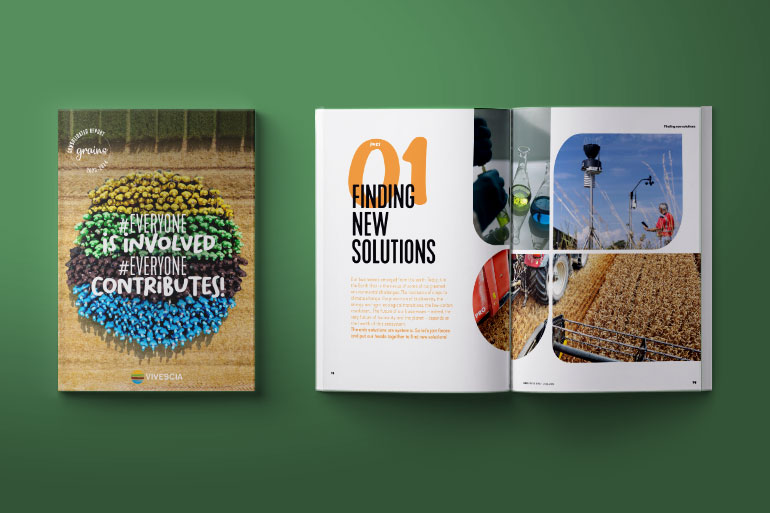Conservation farming: live from a VIVESCIAgrosol field trip


9.15 am - At "Le Balai", a field in the hills above the village of Cuchery: Rolling hills, dazzling sun, a light breeze… We are with agronomic engineer and coordinator of the VIVESCIAgrosol club, Jean-Luc Forrler, a tireless activist for conservation farming. Around 20 farmers are already there. After a few warm handshakes, conversations break out in small groups over a warm coffee. The field trip will soon begin!
VIVESCIAgrosol field trips all follow a certain ritual. Early adopters and recent converts to conservation farming alike, no one wants to miss this monthly meet-up. This agronomic technique cannot be improvised: you need training. And to learn, there's nothing quite like conversations in the field. As a regular says, "you always learn something!"
When Jean-Luc Forrler drums up his troops, everyone circles round to listen to his tips and comments based on a case study: today, the club's members are visiting a field cultivated by Stéphane Schumacher.
The day's host talks about his land and his experience
That's the principle: every VIVESCIAgrosol field trip is organised on one of the members' farms. Stéphane starts by describing the field's characteristics: a steep incline, heavy clay soil with lots of stones… "In short, it's s****y land!" he concludes with a laugh. Hence the benefit of returning organic matter to the soil with cover crops. It naturally enriches the soil and eliminates the need for tillage — which is difficult in these conditions – protecting the root system, facilitating water infiltration, and avoiding erosion. "In any case, with this slope, I can drive the tractor down the hill, but I can't get back up again. I have to go back to the road and drive all the way round to get back to the top, it's a huge waste of time!". He also explains that he sowed immediately after his barley harvest, and in what conditions. Jean-Luc interjects occasionally to comment on some of Stéphane's choices. There is a friendly and welcoming atmosphere. But the discussions between members soon become very technical for the uninitiated…
Technical news by Jean-Luc Forrler
A conservation farming specialist with 22 years' experience, Jean-Luc can rely on a wealth of experience in the field. An agronomic engineer by training, he also learns from scientific studies and keeps a close eye on experiments conducted by various research organisations and, of course, by VIVESCIA. So he regularly presents the results of these studies to his "troops". "Conservation farming demands rigour!", he often says. "It's not magic! Science explains why it is beneficial to avoid soil disturbance."
Today, Jean-Luc has two items to talk about. First of all, he challenges the trend and logic of early sowing before concluding firmly, "we have to stop doing that!". Second subject of the day: fighting insecticide-resistant pests. He opens a big book and points to some tables and aerial photos that illustrate the results of various insecticide trials in different farming systems. "You can clearly see that the key to fighting pests is the choice of farming system." He goes over the agenda, provides the dates of some important conferences he recommends going to, and the speakers, then it's time to visit the field itself!
Following a particularly hot and dry summer, the soil is parched. Near the top of Stéphane's field, among the remains of barley straw from that summer's harvest, a few rape and fava bean plants — precious auxiliaries for capturing nitrogen in the air – are starting to emerge. "At this time of the year, they should be 15 cm tall, not 5 cm", notes a connoisseur, Frédéric, one of the farmers on the field trip. "You can see that it's far more humid further down the hill". As a result, the rape and fava bean plants are far denser there.

A field trip, spade in hand!
Let's be clear: The field trip isn't really a trip! Indeed, on this day, the participants don't explore much of Stéphane's steep field at all. They very quickly gather round Jean-Luc, who has started digging into the soil with his spade. The idea is to get a closer look at it on the surface and underneath. Everyone takes a handfull of earth to examine the cover crops' roots. They discuss clover, Abyssinian mustard, and other legumes (fava bean, vetch, fodder pea, and oats, etc.). They also look for insects or their larvae. People talk about weevils, field mice, caterpillars, slugs and how to fight them. "With the high temperatures this year, the slugs dried out in limey-clay soil. But you need to careful in loam soil, which retains moisture at depth. If it rains, the larvae can hatch and come back up".
Conservation farming is the best remedy for jumping insects like grasshoppers. "With conservation farming, people often say that we work like pigs!” This obviously gets a laugh from the assembled farmers. “Clearly, with cover crops, fields in conservation farming look a little messy next to ‘neatly combed’ ploughed fields with regular furrows. But the most important thing is that it works! In well-prepared fields, good soil coverage is a major obstacle for grasshoppers, so it is very rare for us to have problems with them".
In conservation farming, the main challenge is to preserve the ecosystem. "As long as you spray insecticides that mess up your ecosystem, you will never be up to create a reliable farming system. Is that clear?" says Jean-Luc, firmly but with a smile. That said, he’s not dogmatic. His main concern is the yield, and the farmers' best interests: "So ideally, you don't want to use insecticides," he goes on. "But it's also vital to save your crops. So if you need to spray, you spray! In small doses, and not just any insecticide! If you catch it early in the outbreak, a dose of 0.1 is quite enough".
Naturally, everyone compares Stéphane's field to their own ("I wouldn't have dared to do that!"), people ask their neighbours ("When did you sow? I should have done the same thing…"). One of the participants asks Jean-Luc about moths. "Moths come out at night. So there's no point spraying during the day. You need to do it between midnight and 1 AM. But you don't need to spray just because there are a few small nibbles! If I were you, I would leave it."
Jean-Luc is bombarded with questions! Sometimes two or three at the same time! Everyone talks about what they have done, explains problems they have encountered: Slugs, little snails, birds... Jean-Luc answers unfailingly… He makes diagnostics, suggests specific evidence-based solutions depending on the member's soil and growing conditions, reminds the person of the relevant technique depending on their soil. He encourages and reassures them… His presentation is smattered with anecdotes when needed, recounting the misfortunes of certain farmers who did not follow the protocol. He knows every plot in VIVESCIA's territory and what's going on in the region's fields, including those who plough their land. "And in identical conditions," he likes to remind his audience, "conventional farmers don't have better rapeseed than those who use no-till farming!"
The church in Cuchery rings out for midday. It's already time to conclude this field trip. Some return to their cars. But those who have not had a chance to ask Jean-Luc their questions go to extra time. Others yet linger nearby: you can always learn something from your neighbour's experience and the advice Jean-Luc gives them…

Epilogue...
Jean-Luc eventually returns to his car with a big smile. "It's like that every time. I get bombarded with questions on loads of different subjects. So the VIVESCIAgrosol club's field trips are no walk in the park for me! But it makes me happy to see that more more farmers are making their first steps in conservation farming, that they are persevering, and that they are making progress. About a year ago, the VIVESCIAgrosol club had around 100 members. Now there are more than 350 of them. To stay in close contact with them, I coordinate 18 groups divided over the eight departments in VIVESCIA's territory; with one field trip per month for each group". The price of success? No answer… Jean-Luc waves goodbye modestly and walks off with a little smile. He has a meeting this afternoon with an organisation that would like to benefit from the dynamic he has given to conservation farming. It really is the price of success…
To know more about conservation farming




